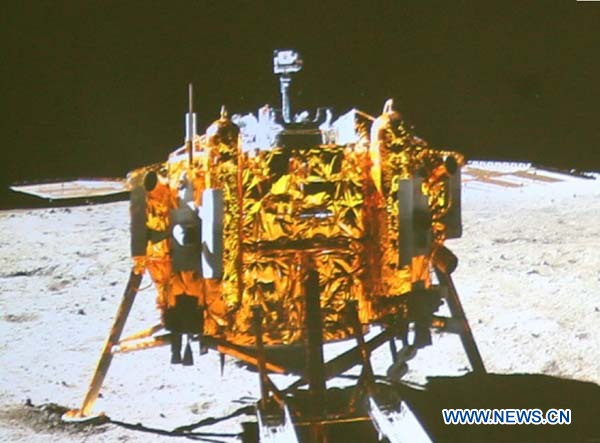 |
| Screen shows the photo of the Chang'e-3 moon lander taken by the camera on the Yutu moon rover during the mutual-photograph process, at the Beijing Aerospace Control Center in Beijing, capital of China, Dec. 15, 2013. The moon rover and the moon lander took photos of each other Sunday night, marking the complete success of the Chang'e-3 lunar probe mission. (Xinhua/Wang Jianmin) |
BEIJING, Dec. 16 -- Five of the eight pieces of scientific equipment aboard Chang'e-3 lunar probe have started to observe space, the Earth and the Moon, a Chinese scientist said on Monday.
They have entered working mode and telescopes and cameras have produced clear images, Zou Yongliao, a scientist with the Chinese Academy of Sciences, said at a press conference.
Comprising a lander and rover Yutu, (Jade Rabbit) Chang'e-3 soft-landed on the Moon on Saturday evening. Yutu later separated from the lander and rolled to moon surface earlier Sunday. In ancient Chinese mythology, Yutu was the white pet rabbit of the lunar goddess Chang'e.
The mission makes China the third country after the Soviet Union and the United States to soft land a spacecraft on lunar soil.
The lander and Yutu each carries four scientific instruments to conduct Moon-based observation, Zou said, adding the lander's cameras took photos of the Moon during its descent.
Yutu and the lander took photos of each other Sunday night through the lander's landform camera and Yutu's panoramic camera. The color images, transmitted live, showed the Chinese national flag on Yutu.
Yutu's radar started working Sunday night to test the structure of lunar soil, according to Zou.
"Chang'e-3 will study the Moon's landforms, geological structure, substance, and potentially exploitable resources," he said, adding, "the lander will observe the Earth's plasmasphere through telescopes."
Scientists from Hong Kong, Macao and Taiwan have participated in the Chang'e missions, and some of the data can be shared by scientists and tech savvy enthusiasts all over the world, Zou added.
Chang'e-3 is part of the second phase of China's lunar program, which includes orbiting, landing and returning to the Earth. It follows the success of the Chang'e-1 and Chang'e-2 missions in 2007 and 2010.
 Heavy cargo flights taking off
Heavy cargo flights taking off In pictures: PLA's digital equipment
In pictures: PLA's digital equipment  Americans mark Thanksgiving Day with parades
Americans mark Thanksgiving Day with parades Love searching stories in cities
Love searching stories in cities  Shanghai shrouded in heavy fog
Shanghai shrouded in heavy fog Office ladies receive ‘devil’ training in mud
Office ladies receive ‘devil’ training in mud Changes in Chinese dancing culture
Changes in Chinese dancing culture  Highlight of Mr Bodybuilding and Miss Bikini Contest
Highlight of Mr Bodybuilding and Miss Bikini Contest  Picturesque scenery of Huanglong, NW China
Picturesque scenery of Huanglong, NW China China's moon rover, lander
China's moon rover, lander Spring City Kunming witnesses snowfall
Spring City Kunming witnesses snowfall Citizens rush to buy cars
Citizens rush to buy cars  Life in an ancient academy
Life in an ancient academy Best photos of the week
Best photos of the week White-collars, black eyes
White-collars, black eyesDay|Week|Month